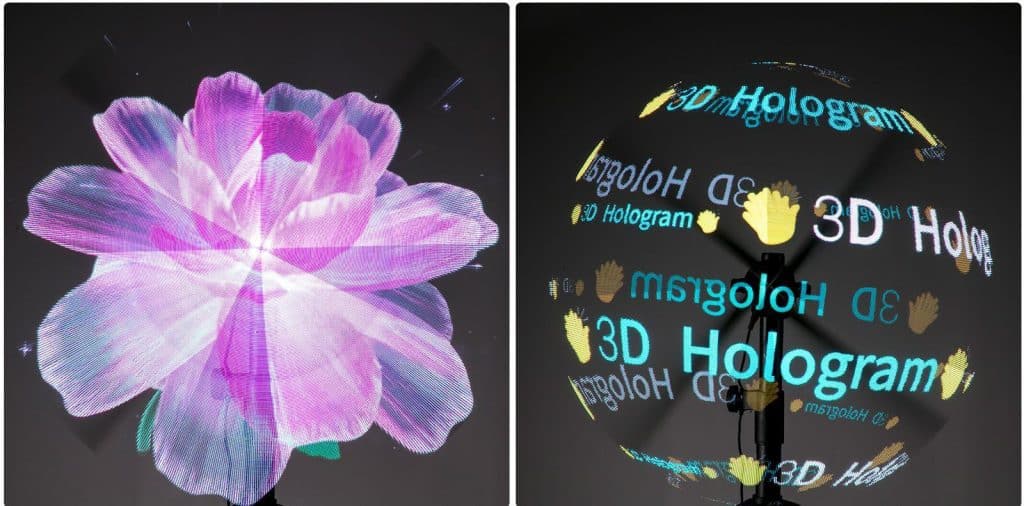Holographic displays are static, resembling 3D images, while 3D holograms are dynamic and lifelike. Advanced technologies such as 3D holographic fan displays and 3D LED fan displays have enhanced presentations, marketing, and education, making visual effects more engaging and immersive than ever before.

Understanding Holograms and 3D Holograms
A hologram is a technology that places an image in space without the need for a screen. These images appear solid but are actually made of light. Holography has been around for many years and is applied in various fields, including science, art, and everyday life.
The concept of holography is elevated in 3D holograms, which create images that appear to float in mid-air. These holograms are more three-dimensional and provide a sense of reality, making it seem as if the object is right in front of you. Today, technologies like 3D holographic fan displays and other advanced tools are widely used for creating stunning visual effects for advertising, education, and entertainment.
How Holograms Work
Before diving deeper into the details of holography, it’s essential to understand light and interference. A hologram is created by splitting a beam of light into two parts. One part is reflected by the object being captured, while the other serves as a reference beam. When these two beams intersect on a photographic plate or suitable surface, they form a pattern of bright and dark lines.
When this pattern is illuminated with a laser or another light source, it recreates a three-dimensional replica of the object. Traditional holograms use laser beams and require controlled conditions to be viewed. While these classic holograms are fascinating, they lack the motion and interactivity offered by modern solutions like 3D holographic fan displays.
How 3D Holograms Work
3D holograms, such as those created by 3D LED fan displays, aim to make images as close to real-life as possible. These devices operate by rapidly rotating LED lights to form patterns that appear as floating 3D images to the viewer.
To create a 3D hologram, computer programs are used to design the content that will be displayed. This design is then transferred to a device like a 3D LED fan or a 3D holographic fan display. The LED lights and precise rotation techniques work together to project the image into space.
One of the key differences in creating a 3D hologram is the combination of depth and interactivity. Some 3D holograms can rotate, move, and even respond to actions, making technologies like LED fan 3D ideal for presentations and marketing. The high-quality visual effects can instantly capture attention.
What's the Difference Between Holograms and 3D Holograms?
Compared to 3D holograms, traditional holograms have several differences.
First, there’s depth. Traditional holograms create a 3D illusion but lack the realism of 3D holograms created with tools like 3D LED fan displays. These 3D holograms offer a more lifelike appearance with better depth and detail.
Second, interactivity is another difference. Traditional holograms are basic and static, while 3D holograms can move and interact dynamically. Devices like 3D holographic fans enable dynamic visual interactions.
Lastly, the viewing angle sets them apart. Traditional holograms often require a specific angle to be viewed clearly, but 3D holograms, especially those created with fan-shaped LED technology, can be viewed by multiple people from various angles without losing clarity.

Use Cases for Holograms and 3D Holograms
In entertainment, holograms have been used to bring legendary performers back to the stage or create mesmerizing shows. For instance, concerts have featured holograms of artists who have passed away. However, 3D holograms take this to the next level with devices like 3D holographic fans, which are perfect for designing captivating stage performances.
In marketing, holograms are used to create eye-catching images. Traditional holograms can project 3D images of products, but 3D holograms powered by LED fan technology can create engaging experiences, such as showing products in motion or highlighting details. 3D holographic fans are also a cost-effective option for businesses looking for a modern touch.
In education and design, holograms and 3D holograms are used where clear explanations are needed. If you want to create an unchanging anatomical model, traditional holograms are useful. However, 3D holograms, supported by tools like 3D LED fan holograms, allow interaction with the model, making complex concepts easier to understand.
Which is Right for Your Business?
The choice between holograms and 3D holograms depends on several factors.
If you only need a basic, non-moving hologram, traditional holography is sufficient. It’s more affordable and requires less setup.
However, if you want something more vibrant and engaging, 3D holograms are the better choice. Devices like LED 3D fans or 3D holographic LED fans are perfect for grabbing attention. These technologies can make a lasting impression during product demonstrations or any form of presentation.
Another factor to consider is cost. While traditional holograms might seem cheaper at first, they lack the charm of 3D holograms. Although 3D holographic fan displays may be more expensive, their benefits far outweigh the costs. Using 3D fan hologram technology, you can create unique experiences that set your business apart.
Conclusion
Holograms and 3D holograms are not interchangeable. Static holograms are ideal for images that don’t need frequent changes, while 3D holograms offer depth, interactivity, and visual appeal. Technologies like 3D holographic fans and LED fan displays bring modern visual effects to life, helping you stand out in today’s competitive world.


